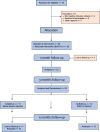Temporalis Muscle Changes Following Botulinum Toxin A Injections in Masseter Hypertrophy Patients: A Randomized Triple-Blinded Trial
- PMID: 38740627
- PMCID: PMC11541289
- DOI: 10.1007/s00266-024-04064-4
Temporalis Muscle Changes Following Botulinum Toxin A Injections in Masseter Hypertrophy Patients: A Randomized Triple-Blinded Trial
Abstract
Background: This study aimed to elucidate the effects of botulinum toxin A (BoNT-A) treatment for patients diagnosed with masseter hypertrophy on the temporalis muscle, with a particular focus on assessing alterations in muscle thickness, electromyographic (EMG) activity, and the development of muscle pain.
Methods: The present randomized triple-blinded clinical trial enrolled 26 female participants aged between 25 and 50 years complaining about masseter hypertrophy. Participants received 75U of BoNT-A (abobotulinumtoxinA) in both masseter muscles and after three months were randomized to receive a second treatment session of saline solution (S-BoNT-A) or BoNT-A (M-BoNT-A). Longitudinal assessments included temporalis muscle thickness through ultrasound, EMG activity, subjective pain, and masseter prominence severity after one, three, and six months of the first injection session. Muscle thickness, EMG, and subjective pain were analysed using two-way ANOVA with repeated measures and post hoc Sidak test, and for masseter prominence severity, Friedman and Mann-Whitney tests were used.
Results: Regarding inter-group comparisons, a higher muscle thickness (p < 0.02) and a higher EMG activity (p < 0.01) were found in the M-BoNT-A group at the 6-month follow-up. For subjective pain assessments, inter-group comparisons showed a higher prevalence of painful regions in M-BoNT-A group at the 6-month follow-up (p < 0.02). No significant differences were found in masseter prominence severity at the 6 months assessment between groups.
Conclusion: BoNT-A treatment for masseter hypertrophy lead to structural and functional changes in the temporalis muscle, presenting higher changes after multiple injections of this treatment.
Level of evidence i: This journal requires that authors assign a level of evidence to each article. For a full description of these Evidence-Based Medicine ratings, please refer to the Table of Contents or the online Instructions to Authors www.springer.com/00266 .
Keywords: Botulinum toxin type A; Masseter hypertrophy; Temporalis muscle.
© 2024. The Author(s).
Conflict of interest statement
The authors declare that they have no conflicts of interest to disclose.
Figures



References
-
- Almukhtar RM, Fabi SG (2019) The masseter muscle and its role in facial contouring, aging, and quality of life: a literature review. Plast Reconstr Surg 143(1):39e–48e - PubMed
-
- Newton J, Cowpe J, McClure I, Delday MI, Maltin C (1999) Masseteric hypertrophy?: preliminary report. Br J Oral Maxillofac Surg 37(5):405–408 - PubMed
-
- Yeh YT, Peng JH, Peng HLP (2018) Literature review of the adverse events associated with botulinum toxin injection for the masseter muscle hypertrophy. J Cosmet Dermatol 17(5):675–687 - PubMed
-
- Mierzwa D, Olchowy C, Olchowy A, Nawrot-Hadzik I, Dąbrowski P, Chobotow S, Grzech-Leśniak K, Kubasiewicz-Ross P, Dominiak M (2022) Botox therapy for hypertrophy of the masseter muscle causes a compensatory increase of stiffness of other muscles of masticatory apparatus. Life 12(6):840 - PMC - PubMed
Publication types
MeSH terms
Substances
Supplementary concepts
LinkOut - more resources
Full Text Sources
Medical
Research Materials

